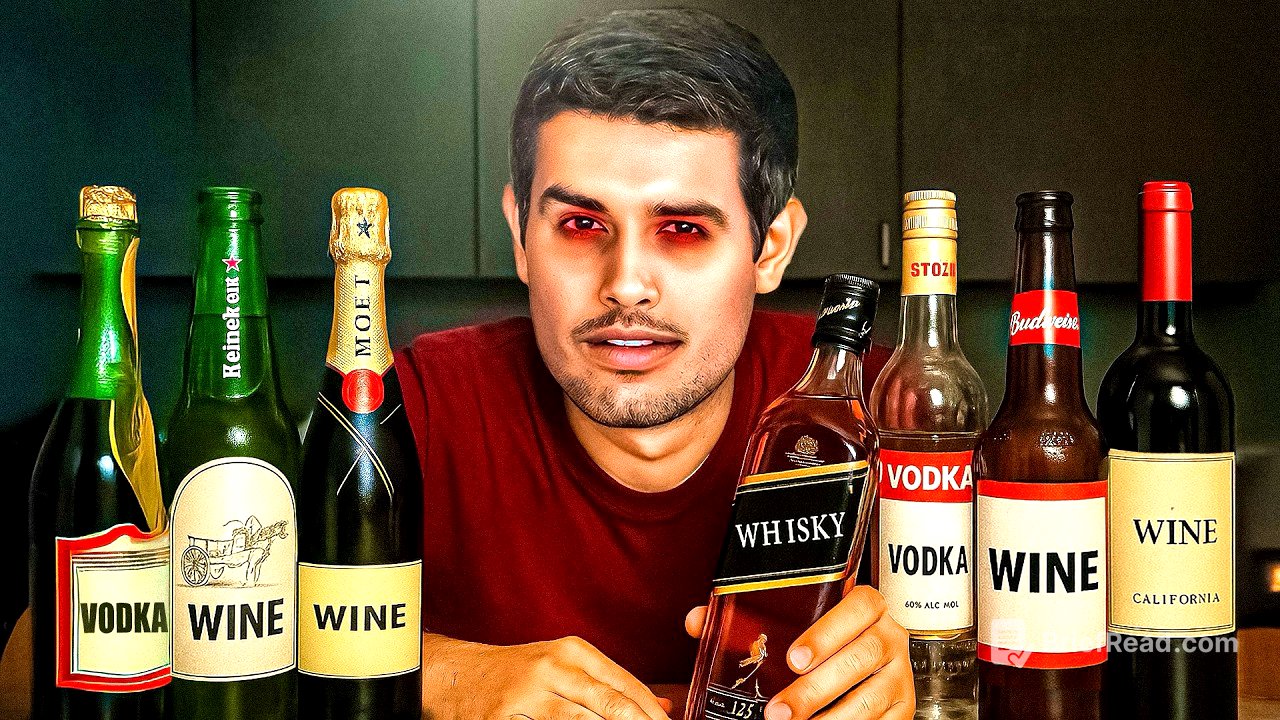Brief Summary
This video by Dhruv Rathee talks about the science, history, and impact of alcohol consumption. It begins with a story of Amit, an average middle-class boy who becomes an alcoholic, highlighting the devastating effects of alcohol addiction on individuals and families. The video then explains the natural origins of alcohol, how different alcoholic drinks are made, and how alcohol affects the body and brain. It also debunks common myths about alcohol, such as the idea that red wine is good for health or that beer is safer than hard liquor. The video emphasizes the addictive nature of alcohol, its impact on society, and the importance of seeking help for addiction.
- Alcohol is naturally occurring and has a history older than humans.
- All types of alcohol, regardless of the drink, contain ethanol, which affects the body.
- Alcohol consumption has negative impacts on the brain, liver, heart, and overall health.
- Myths about the benefits of alcohol, such as red wine being healthy, are debunked.
- Alcohol addiction is a serious issue with social and economic consequences, and help is available through various resources.
Introduction: The Story of Amit
The video starts with the story of Amit, a bright, middle-class boy who becomes an alcoholic after going to college. Initially, he drinks occasionally with friends, but after a heartbreak, he starts drinking daily to cope with his pain. This leads to a downward spiral, affecting his studies and relationships. His family tries various methods to cure his addiction, but nothing works. Eventually, his wife leaves him, and he hits rock bottom. This story highlights the devastating impact of alcohol addiction on individuals and their families, particularly in India, where it affects millions.
The Natural History of Alcohol
The video explains that alcohol is not a human invention but a naturally occurring substance. It existed even before humans. When fruits become overripe, the sugar in them attracts yeast, a single-celled fungus. The yeast eats the sugar, causing fermentation, which releases carbon dioxide and alcohol. Scientists believe that primates, including early humans, consumed these fermented fruits, leading to a tolerance for alcohol over thousands of years. This is known as the Drunken Monkey Hypothesis.
How Different Alcoholic Drinks are Made
Humans have been making alcoholic drinks for thousands of years. In ancient China and Israel, evidence of drinks made from rice, grapes, honey, wheat, and barley has been found. Beer is made when grains are soaked in water and exposed to air, allowing yeast to react and ferment. Wine is made from fermented grapes. Different food items with natural sugar or starch can be fermented into various types of alcohol, such as rice wine, cider, banana beer, and toddy. Distillation is used to create spirits like whisky, rum, vodka, and brandy, which have a higher alcohol content than fermented drinks. Wine is distilled to make brandy, beer to make whisky, sugarcane to make rum, and potatoes to make vodka.
How Alcohol Affects Your Body
When alcohol is consumed, it travels to the stomach and small intestine, where it is absorbed into the bloodstream. Drinking on an empty stomach leads to faster intoxication because the alcohol quickly reaches the small intestine. Carbonated drinks also increase the rate of intoxication. Once in the blood, alcohol circulates throughout the body, affecting organs with high blood flow, such as the liver and brain. The liver breaks down alcohol using enzymes like ADH, which converts alcohol into acetaldehyde (a poisonous chemical), and ALDH, which converts acetaldehyde into harmless acetate. The liver can only detoxify alcohol at a fixed rate, and if alcohol consumption exceeds this rate, it accumulates in the blood, increasing blood alcohol concentration (BAC).
Alcohol's Impact on the Brain
Alcohol primarily affects the brain by influencing neurotransmitters. It increases GABA, which slows down brain activity and promotes relaxation, and reduces glutamate, which keeps the brain active. This impairs neuron connections and reduces brain processing speed. Alcohol also releases dopamine and endorphins, which create feelings of happiness and comfort. Long-term alcohol consumption can shrink the brain, damage the frontal lobe (responsible for decision-making and emotional control), and reduce the size of the hippocampus (related to memory). It can also cause blackouts by blocking the conversion of short-term memory into long-term memory.
Long-Term Health Effects of Alcohol
Regular alcohol consumption has harmful long-term effects on the body. The liver can suffer damage in four stages: fatty liver, hepatitis, fibrosis, and cirrhosis. Cirrhosis is an irreversible stage leading to liver failure. Alcohol also weakens heart muscles, causes irregular heartbeats, high blood pressure, and increases the risk of heart attacks and strokes. It can damage the pancreas, leading to self-digestion, and cause kidney damage, diarrhoea, and painful ulcers. Even occasional drinking weakens the immune system for up to 24 hours.
Debunking Myths About Alcohol
The video addresses several myths about alcohol. The World Health Organisation (WHO) states that no amount of alcohol is safe. The idea that red wine is good for health because of antioxidants is misleading; grapes provide the same antioxidants in greater quantities, and the negative effects of ethanol outweigh any benefits. The notion that beer and wine are "soft drinks" compared to hard liquor is false because the liver processes ethanol the same way regardless of the source. The belief that alcohol keeps you warm is also a myth; it expands blood vessels near the skin, causing heat loss and increasing the risk of hypothermia in cold environments.
Social Impact and Addiction
Alcohol consumption is not only harmful to individual health but also has significant social consequences. It is linked to domestic violence, with women whose husbands drink being at a higher risk of suffering abuse. Drunk driving accidents cause numerous deaths and injuries. Children living in homes where alcohol is consumed are at a higher risk of developing anxiety, depression, and addiction problems. Alcohol is addictive because it hijacks the brain's reward system by releasing dopamine and endorphins, leading to dependence. Tolerance to alcohol increases over time, requiring more alcohol to achieve the same effects.
Alcohol Dependence and Solutions
Alcohol dependence syndrome occurs when the brain's chemistry becomes reliant on alcohol. Quitting at this stage leads to withdrawal symptoms like shaking, sweating, anxiety, and hallucinations. In 2016, alcohol consumption caused 290,000 male and 42,000 female deaths in India. Globally, there are 2.6 million alcohol-related deaths each year. Alcoholics are also more prone to suicide. Poverty and alcohol create a vicious cycle, with alcohol providing a temporary escape from financial stress but ultimately worsening the situation. Illegal and unrefined alcohol, often consumed by the poor, can contain toxic methanol, leading to death.
Amit's Recovery and Seeking Help
Amit's story has a positive ending. After his family intervenes, he joins Alcoholics Anonymous (AA) and begins his recovery. With support and commitment, he overcomes his addiction and becomes a successful entrepreneur. The video emphasizes the importance of admitting the problem and seeking help. Resources like the government's toll-free helpline (14446) and support groups like AA are available. The video also encourages viewers to promise themselves not to drink alcohol and to share the video with friends who pressure them to drink. It calls for challenging the mentality that "one drink won't harm you" and urges the government to control surrogate ads and address alcohol-related issues.









